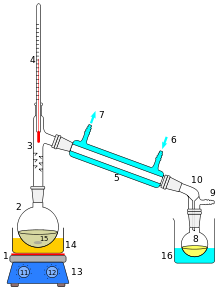This article needs additional citations for verification. (December 2009) |


Round-bottom flasks (also called round-bottomed flasks or RB flasks) are types of flasks having spherical bottoms used as laboratory glassware, mostly for chemical or biochemical work.[1] They are typically made of glass for chemical inertness; and in modern days, they are usually made of heat-resistant borosilicate glass. There is at least one tubular section known as the neck with an opening at the tip. Two- or three-necked flasks are common as well. Round bottom flasks come in many sizes, from 5 mL to 20 L, with the sizes usually inscribed on the glass. In pilot plants even larger flasks are encountered.
The ends of the necks are usually conical ground glass joints. These are standardized, and can accept any similarly-sized tapered (male) fittings. 24/40 is common for 250 mL or larger flasks, while smaller sizes such as 14/20 or 19/22 are used for smaller flasks.
Because of the round bottom, cork rings are needed to keep the round bottom flasks upright. When in use, round-bottom flasks are commonly held at the neck by clamps on a stand.
A round-bottom flask is featured prominently on the logo of the OPCW, the implementing body for the Chemical Weapons Convention.[2]
- ^ "OCS Lab Equipment: round Bottom Flask." Department of Chemistry. University of Nevada.
- ^ "OPCW Logo". OPCW. Retrieved 2020-08-13.